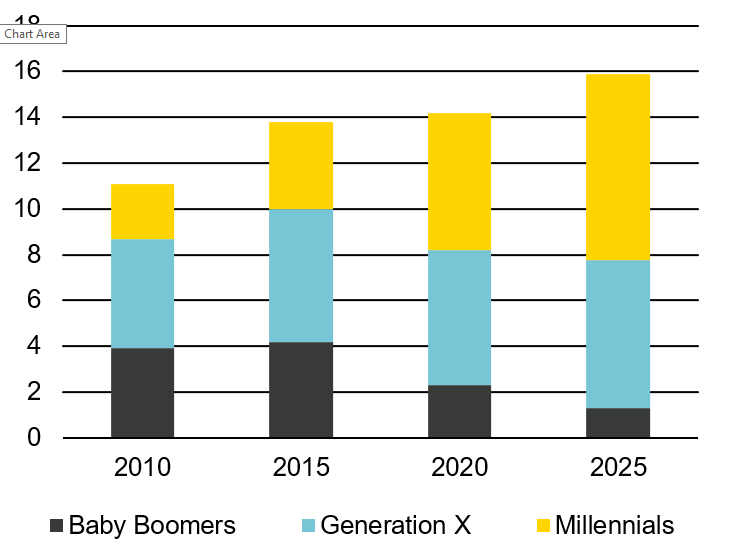Megatrend “Technological Change”
New digital technologies are changing the world as we know it. How do they interact with other global megatrends? How are they shaping the future?

Rapid technological progress changes our preferences and disrupts entire sectors. The mobility sector is one of them. Suburban lifestyles largely dependent on cars are evolving into urban lifestyles favored by Millennials, who are eager and therefore early adopters of the new mobility solutions offered. Entire sectors need to adapt to these upcoming changes, or be at risk of disruption.
The spending power of global Millennials – who reached adulthood around the turn of the century – is set to overtake that of generation X – those born between the mid-60’s and early 80’s – by 2020 and will then continue to rise. Millennials’ demands and needs will shape the future of businesses in the coming decades. We now already notice that they run their lives differently from their parents, preferring to live in cities, and both shop and stay in touch online. The spending pattern of Millennials is consequently quite different compared to previous generations.
Income by generation in the US (in USD trillion)

Source: White House Council of Economic Advisors
Numerous car manufacturers inject large amounts into research and development to create autonomous driving (AD) solutions. The AD market will one day reach USD 10 trillion, according to Ford’s CEO. By 2040, some 33 million self-driving cars, representing a quarter of total global vehicle deliveries, could be sold, according to an IHS estimate.
Micro-mobility solutions such as e-bikes and e-scooters are another trend, booming in our cities. Not only are they two to three times faster than a car stuck in traffic, their cost per mile is a third of a car’s and they also only need a 10th of the space required by a car. This is particularly important, given that roads and parking spots take up to 50 percent of the space in cities, said participants of the ‘Making Cities Great Again’ panel at the Disruptive Technology Symposium organized by Goldman Sachs in London. According to them, other positive outcomes are that micro-mobility solutions result in lower emissions and less congestion. This is an important aspect, given that the average speed in large cities such as London is a mere 8 km/h (5 mph) during working hours. Goflash, a German start-up renting out e-scooters, is among the companies surfing on this mobility wave. It plans to be present in 70 cities by 2020, and rolled out its e-scooters in Zurich last month.
Lilium, another German start-up, focuses on developing an on-demand air taxi service with flying jets that are able to reach a speed of 300 km/h. This would make them six times faster than traditional taxis, but still affordable. A flight between the JFK airport outside New York and Manhattan would cost USD 78. Given the vertical start of the jet, it only requires a small and open landing platform on a building. According to Lilium, the value of the flying taxi market is estimated to reach between USD 0.7-1.7 trillion by 2040. Lilium targets to complete its first manned flight in the coming months, and aims to enter the market in 2025. In the beginning there will be a pilot on board of their jets, but the long-term goal is to let them fly on their own with passengers on board.
Disruptors have a high likelihood of benefiting from the rapidly rising spending power and preferences of the Millennials as well as Emerging Market consumers, which are a rapidly growing category. Such companies are likely to be technology-powered, driving modern progress, and can be either established by tech-driven firms or new entrants.